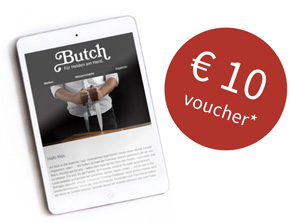
Utility Knife – Your Versatile Hero in the Kitchen
Do you know the feeling? You're in the kitchen, constantly switching between three different knives and wondering why you can't just have ONE decent knife for (almost) everything? That's exactly why utility knives were invented – for people who don't want the constant knife stress.
With a good utility knife, you can easily cut vegetables, meat, and even the occasional block of cheese. It's the Swiss Army knife of kitchen tools, just without the unnecessary corkscrew that you never use anyway. The perfect balance between the bulky chef's knife and the delicate paring knife, essentially the golden middle ground for those who don't want to constantly juggle different blades.
Our utility knives come without frills, but with plenty of bite. They are the multitaskers that won't let you down when you need to move quickly. And let's be honest: Which hobby cook really needs 17 different knives just to prepare a dinner? Exactly – no one.
So, grab a decent utility knife and simplify your kitchen life. Your fingers (and your overcrowded kitchen drawer) will thank you.
Frequently Asked Questions about Utility Knives
What is a utility knife?
A utility knife is a versatile kitchen tool with a medium-sized blade approximately 12-15 cm long. It is characterized by its universal applicability and bridges the gap between the larger chef's knife and the smaller paring knife. The blade is usually slightly curved and tapers to a point, allowing for both precise cuts and general cutting tasks.
What do you cut with a utility knife?
A utility knife can handle a variety of cutting tasks, including:
- Cutting, dicing, and slicing vegetables and fruits
- Cutting and preparing smaller pieces of meat
- Chopping herbs
- Slicing cheese
- Slicing bread and rolls (for occasional use)
- Garnishing and decorative cuts
It is particularly suitable for situations where you need to quickly switch between different cutting tasks without constantly changing the knife.
What is a utility kitchen knife used for?
A utility kitchen knife is used for daily cutting tasks in the kitchen where neither a large chef's knife nor a small paring knife is optimal. It is particularly practical for:
- Medium-sized cutting tasks that require precision
- Meal preparation where various ingredients need to be cut
- Quick kitchen tasks where frequent knife changes would be impractical
- People with smaller hands who find a chef's knife too large
- On the go or in small kitchens where there is little space for many different knives
It is the ideal knife for hobby cooks and a perfect companion for everyday kitchen work.
What is the difference between a chef's knife and a utility knife?
The main differences between a chef's knife and a utility knife are:
- Size: Chef's knives typically have a blade length of 20-25 cm, while utility knives are significantly shorter at 12-15 cm.
- Weight: Chef's knives are heavier and more robust for powerful cuts, utility knives are lighter for more precision and maneuverability.
- Blade shape: Chef's knives usually have a wider blade with a curved edge for rocking cuts, utility knives have a narrower, often straight blade for precise work.
- Application: Chef's knives are suitable for large cutting tasks such as cutting large vegetables or meat, while utility knives are more versatile for smaller to medium tasks.
In professional kitchens, both types of knives are used for different tasks, while for hobby cooks, a good utility knife is often sufficient to handle most kitchen tasks.
Which utility knife is best for the kitchen?
An ideal utility knife for the kitchen should have the following features:
- Blade material: High-quality stainless steel with a hardness of 56-60 HRC for good edge retention and easy sharpening.
- Blade length: 12-15 cm - sufficient for versatile applications, but not too large for precise work.
- Handle ergonomics: A comfortable, non-slip handle that fits well in the hand and provides a secure grip.
- Balance: The knife should be well-balanced to allow fatigue-free work.
- Blade shape: A slightly curved edge with a pointed tip for versatile use.
- Full tang: A full tang provides additional stability and durability.
For daily use, a mid-range utility knife is recommended, offering a good compromise between quality, durability, and price. High-quality utility knives with these features are a worthwhile investment for any kitchen.
What is the difference between a utility knife and a paring knife?
Utility knives and paring knives differ in several important aspects:
- Size: Utility knives have a medium blade length of 12-15 cm, while paring knives are significantly shorter at 6-10 cm.
- Blade shape: Utility knives have a more versatile, often slightly curved blade, while paring knives usually have a narrow, straight or slightly curved blade.
- Purpose: Utility knives serve a variety of cutting tasks, while paring knives are specifically designed for precise tasks such as peeling, garnishing, and removing seeds.
- Handling: Paring knives allow more control for delicate tasks due to their compact size, while utility knives offer more versatility for medium cutting tasks.
Ideally, both types of knives complement each other in the kitchen: the paring knife for small, precise tasks and the utility knife as a versatile all-rounder for most other cutting tasks.
What is the best all-round kitchen knife shape?
The best all-round kitchen knife shape for versatile purposes is characterized by the following features:
- A medium blade length of 12-15 cm, offering a good compromise between manageability and cutting performance
- A slightly curved edge, suitable for both slicing cuts and rocking motions
- A medium-width blade, providing enough stability while remaining maneuverable
- A pointed tip for precise work
- An ergonomic handle that supports various grip techniques
The classic Santoku shape or the European utility knife shape with a slightly curved blade best meet these criteria and are therefore excellent as versatile kitchen helpers. The choice between these shapes often depends on personal preferences and one's own cutting technique.
Which knife is considered a good all-round knife?
Good all-round knives are mainly considered to be:
- Classic utility knife: With a blade length of 12-15 cm and a versatile shape suitable for most kitchen tasks.
- Santoku: The Japanese-inspired utility knife with a blade length of 14-18 cm and a straight edge is excellent for vegetables, meat, and fish.
- Small chef's knife: A more compact version of the classic chef's knife with a blade length of about 16-18 cm offers good versatility.
- Gyuto: The Japanese equivalent of the Western chef's knife is often slightly lighter and more maneuverable with similar versatility.
A good all-round knife is characterized by versatility, balanced proportions, and high material quality. It should be suitable for at least 80% of all common kitchen cutting tasks and fit comfortably in the hand. The choice should ultimately fall on a model that matches one's hand size, cutting technique, and most frequent kitchen tasks.
















